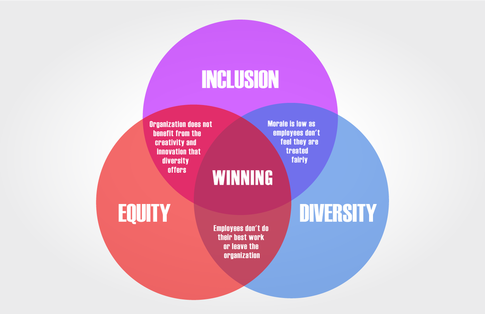|
More and more organizations are beginning to undertake workplace diversity and inclusion (D&I) programs. But oftentimes we find that organizations aren't taking a comprehensive approach to creating an inclusive organization, which means addressing equity, diversity and inclusion. Often, they address one aspect, but not the other. Few organizations even distinguish between equity, diversity and inclusion and address each in their D&I strategy. For some organizations, their efforts live in the human resources department. So they review may human resource policies and practices through an equity lens and may even tighten up their procedures for hiring.
Equitable hiring and human resource policies help create the infrastructure needed to support the creation of a diverse workforce and inclusive organization. Equity ensures that the organization is hiring from a diverse group of competent staff. Equitable policies and practices also help ensure that the organization is complying with human rights and other equity-related legislation. A focus on equity is necessary, but on its own is not sufficient to creating a diverse workforce and may not be sufficient to ensure that managers are creating an inclusive work environment. Similarly, a focus on diversity on its own offers little benefit. Hiring to create a diverse workforce without ensuring that hiring practices are equitable can create a backlash among employees. When people from diverse communities, backgrounds and identities are being hired through what is seen to be an unfair process, they could be seen as token hires and unqualified for the job. The morale of existing employees could also drop as employees feel that they are not treated fairly. If the work environment is not inclusive, employees from diverse backgrounds could quickly be isolated, their performance could decline, and they could leave the organization in search of a more welcoming organization. A diverse organization without good and inclusive people management practices could mean that conflict, harassment and discrimination go unaddressed. If diversity is the mix, inclusion is about making the mix work. This includes strategies to support managers to manage a diverse workforce and embeds an inclusion mindset into the organizational culture. Some organizations focus on creating an inclusive organizational culture. They conduct cultural competency training, have potluck lunches and recognize various cultural and religious celebrations. But they may be missing a focus on creating the infrastructure needed for equitable hiring and a strategy to diversify the workforce. Creating an inclusive work environment is important to getting the best from all employees. But an organization that doesn't have much diversity may not get the benefits of creativity and innovation that a truly diverse organization has to offer. The starting point is a few key shifts in attitude: from compliance with equity-related legislation to seeing EDI as an essential element of organizational success; from hiring as usual to a focus on bias-free hiring and equitable hiring practices; and from diversity alone to ensuring that all employees benefit from an inclusive organizational culture and work environment. When equitable hiring and human resource policies and practices are coupled with a diverse workforce and an inclusive organizational culture and work environment, that is when we can create truly inclusive organizations and when we will be winning.
1 Comment
Anneliese Renck
2/25/2022 11:40:59 am
Hello,
Reply
Your comment will be posted after it is approved.
Leave a Reply. |
TANA TURNERTana Turner is Principal of Turner Consulting Group Inc. She has over 30+ years of experience in the area of equity, diversity and inclusion. Categories
All
|

